An Evaluation of the Commonwealth Games 2014 Legacy for Scotland Report 1: Questions, Methods and Baseline
This report sets out the broad approach to the Glasgow 2014 legacy evaluation,the research questions it will address, and the range of methods that will be deployed between now and 2019. It also sets out the priorities for the next 18 months and a forward timetable for publication of reports.The report also has a series of Annexes on the 4 national themes (flourishing, active, connected and sustainable).
Annex 1: Flourishing
Introduction
Both the Scottish Government and Glasgow Legacy Plans emphasise the potential that the Commonwealth Games 2014 offer to contribute to the health of the Scottish and Glasgow's economy, now, during and after the event. The legacy plans focus on the opportunities to strengthen Scottish business, to provide pathways to employment, to foster a culture of volunteering, and to enhance Scotland and Glasgow's international profile as a tourism and events destination.
The recent economic downturn and government spending cuts provide an important backdrop for the evaluation of legacy. As the July 2012 'State of the Economy Report' by Scotland's Chief Economist highlights, 14 the recovery of the Scottish economy remains fragile, with uncertainty from Europe continuing to impact on confidence and investment. Nonetheless, there are hopes that global growth will gather momentum in 2013.
The recent labour market performance in both Scotland and the UK has been mixed and it is yet unclear which direction the future trend will take. Global economic instability and uncertainty continue to exert downward pressure on confidence and demand, posing risks to sustained labour market recovery in both Scotland and the UK as whole in the near term.
Previous Research
There is a substantial body of research that indicates that economic growth can happen as a result of hosting a major sporting event.15, 16 The sustained nature of that growth has been less well researched. It is important to note though, that many of these studies are based on estimated data rather than actual data. Several studies show increases in employment, although there was some concern about the long-term sustainability of these employment opportunities.17, 18, 19, Employment in the construction industry tends to be short-term, but important nonetheless, and perhaps especially so at a time of recession where aggregate demand in the economy is subdued. Investment is a key component of economic growth - both in the short term (by boosting demand in the economy) and in the long term (through its effects on productivity). Further, increased opportunities in the tourism and events industry are dependent on sustained levels of tourism and events business.
Alongside creating and supporting employment, there has also been a focus on improving people's chances on the job market in previous Games, through gains in qualifications and skills, often through volunteering schemes. The Manchester 2002 Commonwealth Games targeted their volunteering programme at disadvantaged groups which has been claimed to increase confidence and aspirations, as well as volunteering opportunities in the future.20, 21, Manchester's approach of targeting disadvantaged groups was very different from the more common strategy of recruiting volunteers who are already skilled and qualified. A total of 127 participants have completed the Personal Best Pilot programme in Glasgow. The programme, similar to that developed for the Manchester Games, offers accredited training to those who have found it difficult to gain entry to the labour market. Evidence from the Glasgow programme has been positive and has informed new developments.22
A study looking at 18 major sporting events found an average increase of 8% in tourist numbers.23 However, there was a large difference between different types of events, with Summer Olympics and FIFA World Cup generating much more tourism than Winter Olympic Games.24 Moreover, the authors found that this increase was only short-term. Three years following the events there was no average increase in tourism. Several other studies have also noted the lack of long-term tourism impact.25 Again, a sustained improvement in tourism requires a clear post-Games strategy. Related to this is the substantial body of research highlighting the problem of long-term use of event infrastructure, often referred to as the problem of 'White Elephants'. This research suggests that one of the crucial factors for the lack of success was that there were no long-term plans for legacy.26 The degree to which the new infrastructure fits with the medium to long-term economic goals of a nation and city will also be important. In Scotland, £269 million of investment in what will be Games venues was planned prior to the bid - £128 million by Glasgow City Council, £29 million by Edinburgh City Council and £112 million by the Scottish Exhibition and Conference Centre.27
Strategies and Programmes
For Glasgow2014 legacy planning on the 'flourishing' theme commenced well in advance of the Games, and indeed was a key driver for submitting the bid in 2007. There is a wealth of activity underway on the 'flourishing' theme which we have briefly summarised below as business support and investment, direct employment, employability programmes and volunteering and international reputation.
Business support and investment
There are a number of important initiatives in place to support businesses. The Commonwealth Games Business Portal was launched in 2009, and relaunched in 2011 as the Glasgow Business Portal, to advertise Games contracts. As of 30 June 2012 there were 19,499 Scottish registrations on the Glasgow Business Portal.28 A total of £276m of Tier 1 contracts have been awarded to date, with £250 million of these to Scottish companies. The total number of contracts awarded up to June 30th 2012 was 418. Of these, 312 (75%) have been let to Scottish companies, and there are still substantial contract opportunities to come.
The experience of and lessons learned from the London 2012 portal, CompeteFor, have informed the enhancement and management of the Glasgow Business Portal. It also appears to have helped the business community to better understand the use of electronic portals and to mitigate their concerns about the difficulty of accessing public sector contracts. It is hoped that the experience of using CompeteFor means that they are in a better position to be business ready and able to go for Commonwealth Games contracts. Evidence for CompeteFor indicated that 33% of those who has used the Portal said that they would use the experience of bidding through CompeteFor to bid for wider government or public sector contracts.
BusinessClub Scotland delivers its aims and objectives through partnership working with Scottish Council for Development and Industry, Scottish Chamber of Commerce, Institute of Directors, Federation of Small Business, EventScotland, and Scottish Enterprise. In principle this should add value to what is already being delivered by partner agencies and avoid duplication of resource. Key aims and objective are to support the business community to exploit economic opportunities available from major sporting and other events hosted in Scotland. To date they have 3,245 members.
It is also important to note that Glasgow has already secured new conference and event business using the infrastructure developed for the Commonwealth Games. It is hoped that this in turn will continue to help bring in new business and investment. The state-of-the-art facilities improved or built for the Glasgow 2014 and the 17 sports have enabled Glasgow and Scotland to secure 23 high-profile national and international events at the time of writing. The securing of some of these pre-Games events reflect the intention to ensure legacies are derived in advance. This is in contrast to the 'test events' usually held immediately in advance of Games and primarily for the purpose of testing Games delivery. The addition of the Scottish Hydro Arena (due to open in 2013) is also significantly enhancing this infrastructure. In 2014 Scotland is also hosting The Ryder Cup and Scotland's Year of Homecoming 2014. All the key agencies are working together to ensure that they have strategic plans in place that will capitalise on the opportunities that will flow from all the major events, both local and global that will happen over the next decade.
Tourism
VisitScotland are working to use the equity of the Commonwealth Games in 2014 as part of a shared approach to Scotland welcoming the world. This approach will include Homecoming 2014, the Ryder Cup and other major events spanning 2014. VisitScotland aims to identify and convert these opportunities and the Commonwealth Games in Glasgow to deliver additional tourism benefits to the visitor economy, at the same time as demonstrating Scotland's credentials as the perfect stage for hosting major global events, sporting and cultural. In the Scottish Draft Budget 2013/2014 VisitScotland will receive an additional £1.5 million in 2012-13 for marketing campaigns to attract visitors and revenue to Scotland, and receive additional resource from budget consequentials of £1.2 million in 2013-14 and in 2014-15 to support the Scottish Open golf tournament.
A strategic outline has now been agreed with VisitScotland and Glasgow 2014 Organising Committee (OC), which will see extensive cross-messaging across the organisations' core marketing activities to target both Games fans and core domestic and international traveller audiences. In addition specific markets including athletes' family and friends, and long-stay, higher yield visitors from Canada, Australia and India may be targeted in a partnership approach involving VisitScotland, Glasgow City Marketing Bureau and the Organising Committee. Extensive work to exploit broadcast opportunities during the 2012 Olympics for the promotion of Scotland and our Year of Creative Scotland messages has already built valuable relationships ahead of 2014, when VisitScotland will again exploit these for global communication of Scotland's strengths.
Employment
Employment is being supported directly in a number of ways by the Games preparation, delivery and legacy. The Organising Committee (OC) continues to be a major source of employment leading up to Games time. It is steadily recruiting to fill key positions to build a core team that will comprise around 1,100 staff. It also has a substantial number of contract opportunities for supplies and services required for the Games, many of which are still to come.
There have been a large number of contract opportunities for supplies and services around the construction of the Games venues, resulting in employment. Some of that employment will, by its nature, be temporary. Overall spending on the construction and refurbishment of venues, and the Athletes Village in the six years leading to 2014 is estimated to support an average of around 1,000 jobs in each year (see para. 2.33). In addition, the URC's Games-related construction and refurbishment projects have directly supported around 170 jobs up to the end of March 2012. Once complete, these projects can potentially support a significant number of full time equivalent jobs. At the next stage, as venues come on stream, jobs in other sectors will be supported. All these activities support other indirect and induced jobs in the economy.
Further, a number of specific Games-related employability funds and programmes have been launched:
- The Scottish Government launched a Legacy 2014 Young Persons Fund in March 2012 with the aim of giving 2,500 young people the opportunity to gain employment opportunities at the major events Scotland will host in the years to come. The first of two programmes of activity is now underway. Skills Development Scotland (SDS) is providing incentives to employers to offer sports or events-related Moden Apprenticeships (MAs) for 16-19 year olds anywhere in Scotland. This includes MA frameworks that feature an element of sport, retail, events management, and hospitality which support the sports industry in Scotland.
- Glasgow City Council have also launched their Commonwealth Apprenticeships Commonwealth Jobs Fund and Graduate Programme. Since the launch of these GCC initiatives, 2,026 young people from across Glasgow have started Apprenticeships. Glasgow City Council continues to work to ensure that this investment in apprenticeships results in long term labour market success for the young people.
- 57 previously unemployed, young people from across Glasgow have secured employment through the Jobs Fund, which has been extended to include 16 and 17 year olds.
- Community Benefit Clauses in Glasgow City Council let Games-related contracts aim to help get local people into employment. They place a legal requirement on public sector contractors to employ 10% of their project workforce from key target groups, including the long term unemployed.
Volunteering
The Games also offer the opportunity to get the Scottish public involved, or further involved, in volunteering in all sorts of ways. The Glasgow 2014 Organising Committee has now developed a volunteering strategy for the Glasgow 2014 Games. Around 15,000 volunteers will be needed for the Glasgow 2014 Games, and recruitment will begin shortly. Volunteering is central to the successful delivery of all major sporting events. The volunteers required will cover the broad spectrum of roles and responsibilities at the Games, including the most technical and specialist roles. There may be an opportunity to build on the experience of individuals from Scotland who were Gamemakers in London2012.
There are a number of other volunteering initiatives either underway or at the planning stage. For example:
- EventTeam Scotland, launched in January 2011, is an online database which 'matchmakes' event volunteers and event organisers. It provides a one-stop shop to allow volunteers to link with events, gain experience, use existing skills, gain new skills, and enjoy events. The site has had over 1,400 volunteer registrations with 62 events registered 25 of which are live events offering opportunities.
- People Making Waves is a UK-wide volunteering programme inspired by London 2012 inviting volunteers to connect with the Olympic and Paralympic Games through a range of cultural activities. Since its launch in 2009, it continues to help share the experience of volunteering across its four projects. People across Scotland are already getting involved with over 1300 members and 500 stories of volunteers' experiences on the website. For more information please visit People Making Waves.
- There are 113 Youth Legacy Ambassadors (YLA) across Scotland whose role is to champion the legacy of the Glasgow 2014 Game (and of London 2012) to other young people and their local community and help promote the benefits major sporting events can bring and leave behind for Scotland's young people. The work of the Youth Legacy Ambassadors is complemented by over 300 young ambassadors recruited across local authorities with the help of Youth Sport Trust and sportscotland to support London 2012's ambitions to involve young people and increase participation in sport. The work of both these groups of ambassadors will add significantly to the local reach of the Games.
- During London 2012, four YLAs were successful in securing internships at Scotland House as young social reporters. The young people attended various Olympics events and created blogs, videos, reports and diaries about the Scotland House Olympics activities. Several other YLAs were in London during the Olympics in various roles. Youth Legacy Ambassadors also took part in the first International Cultural Summit held at the Scottish Parliament. Four YLAs were recruited to the position of Delegate Aid, collecting the delegates from the airport and being their first point of contact for the event.
- Glasgow Life is leading on the Host City Ambassador programme. The programme recruited 192 Host City Ambassadors to ensure that the Olympic events in Scotland - the football matches at Hampden Park - ran efficiently and gave the visitors, the spectators, the residents, and the volunteer a valuable experience. The Ambassadors were trained and supported and have been encouraged to continue volunteering after the Olympics, paving the way for them to be recruited in 2014.
Civic pride and international reputation
Finally, partners are keen to use the opportunity of the Games to increase civic pride in Scotland, and enhance the international reputation of Scotland. This is relevant to a number of the legacy themes, including 'flourishing'. There is no single effort or 'programme' that aims to achieve this, but there is an aspiration that the overall Games effort will increase civic pride and international reputation. We have included indicators in our work which will help measure whether these have changed over time.
Flourishing- Headline Indicators
| HEADLINE INDICATORS | Scotland | Glasgow | East End | Source |
|---|---|---|---|---|
| INTERMEDIATE OUTCOME: Increase growth of Scottish businesses | ||||
| F1: Gross Value Added (GVA) in key sectors | √ | √ | X | ABS |
| F2: Business stock - number of business sites in key sectors: | √ | √ | SCSS | |
| INTERMEDIATE OUTCOME: Increase movement into employment, training and volunteering | ||||
| F3: Employment in key sectors | √ | √ | X | BRES |
| F4: Claimant Count - Number and proportion of people on unemployment benefit, alongside unemployment data. | √ | √ | DWP | |
| F5: School leavers in sustained positive destinations - percentage reported annually. | √ | √ | X | SLDS |
| F6: Modern Apprenticeships - number of New Starts, In Training, and Leavers. | √ | √ | X | SDS |
| F7: Adults providing unpaid help to organisations or groups - percentage reported annually, by type of unpaid help | √ | √ | GW | SHS |
| INTERMEDIATE OUTCOME: Improve the perception of Scotland as a world class destination for business, events and tourism | ||||
| F8: Perception of Scotland internationally - exports. | √ | X | X | NBI |
| F9: Perception of Scotland internationally - tourism. | √ | X | X | NBI |
| F10: Rank and score as a business location - best city to locate a business in today among European cities. | X | √ | X | CW |
| F11: Rank and score as a major event destination - Glasgow. | X | √ | X | TBD |
| F12: Tourist Visits - Overseas & UK Tourists (Trips). | √ | √ | X | IPS/ GBTS/UKTS |
| F13: Tourist Expenditure - Overseas and UK Tourists Expenditure (£). | √ | √ | X | IPS/ GBTS/UKTS |
| F14: Hotel occupancy (Glasgow) - Annual Average Hotel occupancy (%) and July-September occupancy. | √ | √ | X | SAOS |
√ available x not available / not applicable GW - through the GoWell study ![]() context ABS - Annual Business Survey; APS - Annual Population Survey; BRES - Business Register Employment Survey; DWP - Department of Work and Pensions; SDS = Skills Development Scotland; SHS - Scottish Household Survey; NBI-Nations Brand Index; IPS - International Passenger Survey; GBTS/UKTS = Great Britain Tourist Survey/UK Tourism Survey; SAOS = Scottish Accommodation Occupancy Survey; CW - Cushman & Wakefield.
context ABS - Annual Business Survey; APS - Annual Population Survey; BRES - Business Register Employment Survey; DWP - Department of Work and Pensions; SDS = Skills Development Scotland; SHS - Scottish Household Survey; NBI-Nations Brand Index; IPS - International Passenger Survey; GBTS/UKTS = Great Britain Tourist Survey/UK Tourism Survey; SAOS = Scottish Accommodation Occupancy Survey; CW - Cushman & Wakefield.
Tracking Indicators Since Baseline
In this section we look at the latest available data for all the 'flourishing' indicators and examine recent trends since 2008. We also look briefly at what we know about the outcomes for sub-groups, where appropriate and available. Some of the economic data has a long time-lag from collection to publication, so in some cases data only to 2010 are available.
It is important to note at this stage, as set out in chapter 2, that the indicators presented here are, in theory, amenable to change due to the Games, but they only form part of the picture. As our work progresses, economic assessment, primary research and evaluation will provide the 'bottom-up' evidence that will help assess the contribution of the Games specifically. More of these data will be available for the next report in 2014.
1) Increase growth of Scottish businesses
Two indicators are presented under this intermediate outcome; Gross Value Added (GVA) and business stock. Employment is also relevant, and is presented in the next section. However, arguably changes in these indicators might be seen in certain sectors of the economy, at certain times, rather than across the economy as a whole. So data for relevant key sectors will also be monitored. These have been agreed as:
- Construction;
- Sports activities and recreation education;
- Sustainable tourism;
- Creative Industries; and,
- Manufacture of Food and Beverages.
Data on sports and leisure which is collected as part of sustainable tourism will be presented separately for the purposes of evaluating the impact of the Games. Key sector data also appears under the other legacy theme areas. For example, the GVA for sports activity and recreation education will be used to assess progress on 'active'.
Why is this indicator important? The strength of the economy is measured by calculating the nation's output or Gross Domestic Product (GDP). GDP estimates produced for Scotland are measured in basic prices, which exclude taxes less subsidies in products. Gross Value Added (GVA) is another term for GDP at basic prices.
If the effect of the Commonwealth Games on the Scottish economy is big enough then Scotland's and/or Glasgow's GVA should increase in key sectors at particular times. In the early stages of the Games endeavour we would particularly expect to see a contribution to GVA in the construction sector.
There are a number of different measures of GVA for Scotland:
- The quarterly GDP index is the preferred source for measuring real (inflation-adjusted) GVA change over time - for the Scottish economy as a whole and for broad sectors of the Scottish economy;29
- The Scottish National Account Project (SNAP) published data series is the preferred source for current price (non-inflation-adjusted) GVA - for the Scottish economy as a whole and for broad sectors of the Scottish economy; and,30
- Approximate GVA from the Annual Business Survey (ABS) is the preferred source for current price (non-inflation-adjusted) GVA - for detailed industry sectors within Scotland/local areas.31, 32,
Approximate Gross Value Added (aGVA) represents the amount that individual businesses, industries or sectors contribute to the economy. Generally, this is measured by the income generated by the business, industry or sector less their intermediate consumption of goods and services used up in order to produce their output. As we are interested in measuring GVA of detailed industry key sectors and at a local authority area level for Glasgow we are using the ABS sourced measure of approximate GVA.
Table F1: GVA at basic prices (£m), 2008 - 2010
| Sector | Scotland 2008 | Scotland 2009 | Scotland 2010 | Glasgow 2008 | Glasgow 2009 | Glasgow 2010 |
|---|---|---|---|---|---|---|
| Construction | 7,909 | 5,979 | 5,963 | 1,034 | 930 | 890 |
| Sports activities and Recreation education | 440 | 610 | 429 | 103 | 129 | 92 |
| Of which: Sport & Leisure | 96 | 145 | 114 | 4 | 4 | 5 |
| Sustainable Tourism | 2,594 | 2,768 | 2,882 | 298 | 500 | 291 |
| Creative Industries | 3,031 | 2,748 | 2,671 | 899 | 683 | 620 |
| Manufacture of Food & Beverages | 3,708 | 3,863 | 3,590 | 484 | 473 | 373 |
Source: Annual Business Survey, ONS (Calculations by Scottish Government)
What do the data tell us? As we might expect in an economic downturn GVA has, in the main, decreased across key sectors between 2008 and 2010 - both at national and Glasgow level. The Scottish economy entered recession in early 2008 before returning to growth in late 2009. In some cases, fluctuations are observed rather than a simple downward trend.
F2: Business stock
Why is this indicator important? Any increase in the number of business locations is a good indicator of an active entrepreneurial climate in the economy. For the purposes of this evaluation the number of sites will be measured, rather than the number of enterprises, as this is a more sensitive measure of change within a specific geographical area. In the same way as for GVA the number of businesses in key sectors will be monitored to explore whether change is occurring in specific sectors rather than the economy as a whole.
Business start-ups are also a possible indicator for measuring change in entrepreneurship. However, the stock of business sites is influenced by business start-ups and business survival - and the Commonwealth Games may have an impact on both these elements. Furthermore, official business start-ups rates are measured at an enterprise level, rather than at a business site level - and measuring at an enterprise level reduces the sensitivity. For example, if a restaurant chain (the enterprise) already operating in the East End opens a new restaurant this would not result in an increase in the number of enterprises but would result in an increase in the number of business sites operating in the East End of Glasgow.
What do the data tell us? Overall the number of business sites for key sectors in the East End has remained relatively constant. An overall decrease in construction sites is observed for both Glasgow and Scotland between 2008 and 2011 which we might expect in an economic downturn. In Glasgow business sites for sports activities and recreational education and the manufacture of food and beverages has decreased slightly, and there is a slight increase in sustainable tourism business and creative industries sites. A similar, though not identical, picture is evident at Scotland level.
Table F2: Number of business sites by sector: East End, Glasgow and Scotland
| 2008 | 2009 | 2010 | 2011 | |
|---|---|---|---|---|
| East End | ||||
| Construction | 75 | 80 | 85 | 80 |
| Sports activities and recreation education | 10 | 5 | 5 | 5 |
| Sustainable Tourism | 65 | 65 | 65 | 70 |
| Creative Industries | 80 | 90 | 90 | 90 |
| Manufacture of Food and Beverages | 10 | 5 | 5 | 5 |
| All sites operating in the East End | 935 | 970 | 955 | 940 |
| Glasgow | ||||
| Construction | 1590 | 1615 | 1590 | 1475 |
| Sports activities and recreation education | 155 | 135 | 135 | 140 |
| Sustainable Tourism | 1700 | 1720 | 1745 | 1775 |
| Creative Industries | 1800 | 1850 | 1870 | 1945 |
| Manufacture of Food and Beverages | 95 | 95 | 95 | 85 |
| All sites operating in Glasgow | 19,770 | 19,875 | 19,795 | 19,530 |
| Scotland | ||||
| Construction | 20190 | 20255 | 19585 | 18780 |
| Sports activities and recreation education | 1945 | 1790 | 1840 | 1775 |
| Sustainable Tourism | 15260 | 15455 | 15445 | 15225 |
| Creative Industries | 11445 | 11820 | 11985 | 12345 |
| Manufacture of Food and Beverages | 1225 | 1210 | 1160 | 1095 |
| All sites operating in Scotland | 186,210 | 186,295 | 185,060 | 182,995 |
Source: Inter-Departmental Business Register, ONS (Calculations by Scottish Government)
2) Increase movement into employment, training and volunteering
Five indicators have been selected under this intermediate outcome: employment; claimant count; school leavers in sustained, positive destinations; numbers of modern apprenticeships; and adults providing unpaid help to organisations or groups. In the case of the employment data we are using the same key sectors as for GVA and business stock.
Why is this indicator important? Labour market participation is a key driver of economic growth. Although, there is a limited amount of evidence to suggest that direct employment and contracting of the Glasgow 2014 Games preparation, delivery and legacy will have a positive impact on employment, particularly in Glasgow and the surrounding area, it will be difficult to attribute any increases in directly to the Commonwealth Games using this indicator alone.
There is a wide range of data available to monitor changes in employment, however, for the purpose of this analysis data from the Business Register Employment Survey (BRES) produced by the ONS will be used.
The preferred source of headline employment level and rates, for Scotland and local authority areas, is the Labour Force Survey (LFS)/Annual Population Survey (APS). Data from the LFS/APS will be key to understanding any employment gains amongst specific groups such as young people. However, the BRES is preferred source for estimates of employment by detailed industry for Scotland and local authority areas within Scotland.
Unlike other sources of employment data, the BRES is based on information from employers rather than self-reported by respondents to a household survey. This results in more robust information on the number of jobs by industry compared to other sources such as the Labour Force Survey. However, due to the complexity of the data collection process there are a number of methodological discontinuities which affect time series analysis. There is also approximately a one year lag between collection and publication.
The BRES data is presented from 2009 onwards, as 2009 was the first year of the full BRES survey. BRES produces estimates of employment (employees plus working proprietors) and includes self-employed workers if they are registered for VAT or Pay-As-You-Earn (PAYE) schemes.33
What do the data tell us? Overall, latest data from BRES is broadly in line with employment data from the Workforce Jobs. For Scotland a decrease in employment is observed, between 2009 and 2010, for all key sectors - except employment in the Manufacture of Food and Drink. A similar decrease for Glasgow can be seen accross Construction, Sustainable Tourism and Creative Industries employment decreased between 2009 and 2010. However, for Glasgow employment in the 'Sports Activities and Recreation Education' remained flat between 2009 and 2010, compared to a fall in Scotland as a whole. Construction employment has increased in Scotland as a whole between 2010 and 2011. For Glasgow we can't really draw any firm conclusions on the change in construction employment between 2010 and 2011 - however, it is evident that a sharp fall experienced in construction employment for Glasgow between 2009 and 2010 has not continued into 2011.
Table F3: Employment by key sector (Scotland and Glasgow), 2009-2010 and 201134
| Scotland | Glasgow | |||||
|---|---|---|---|---|---|---|
| Sector | 2009 | 2010 | 2011 | 2009 | 2010 | 2011 |
| Construction | 148,000 | 135,900 | 140,800 | 20,400 | 17,700 | 17,300 |
| Sports activities and recreation education | 34,900 | 33,300 | 38,500 | 3,900 | 3,900 | 4,100 |
| Sustainable Tourism | 191,100 | 184,500 | 185,900 | 26,300 | 25,200 | 24,600 |
| Sport and Leisure also included in Tourism | 15,300 | 14,400 | 15,400 | 900 | 1,100 | 1,200 |
| Creative Industries | 76,700 | 72,100 | 64,100 | 18,700 | 17,300 | 16,900 |
| Manufacture of Food and Beverages | 43,200 | 43,900 | 45,000 | 5,100 | 5,100 | 5,500 |
Source: Business Register and Employment Survey, ONS (Calculations by Scottish Government)
F4: Claimant count - Number and proportion of 16-64 year olds claiming unemployment benefit
Why is this indicator important? This indicator measures the number of people claiming unemployment-related benefits, i.e. Job Seekers Allowance (JSA). People who are out of work or working less than 16 hours a week may be eligible to claim JSA if they are: capable to work; available for work; activity seeking work; and, below the pension age.
We have included this indicator because we know that the Games have, and will continue, to support jobs through direct employment and contracting. It is hoped that any increases in employment as a result of the Games will be driven by decreases in unemployment. Unemployment data is not available below local authority level, whereas claimant count data is available for small geographic areas. One would expect that all people on claimant count to be defined as unemployed, however, not all unemployed people are on the claimant count; some people may choose not to claim benefits whilst others may not be eligible (e.g some under 18's). Consequently the number of unemployed people is always higher than the number of people on the claimant count. Despite this undercount, there are a number of key advantages to using claimant count data: it is available for small geographic areas; it is available on a timely basis; it is from an administrative system so is not subject to sampling error; and, a range of disaggregations are available.
However, we note at this stage that there are wider economic forces and welfare reforms that will have a greater influence on this indicator than the Games themselves, for example the underlying indicator will change as a result of the introduction of Universal Credit. Data from other sources may help us build a more robust picture of the impact of the Games on the unemployed. However, even using the range of data available it will be difficult to attribute any reductions in the claimant count directly to the Commonwealth Games as only limited information is available as to the reasons people leave the claimant count.
What do the data tell us? The number and proportion of people aged 16-64 claiming unemployment benefit rose both in Scotland as a whole and Glasgow between 2008 and 2012. This is a rise in rates from 2.4 to 4.0 at national level, and 3.8 to 5.7 at Glasgow level. There was a very small 0.3 decrease in the rate between 2011 and 2012 in Glasgow. This overall increase in the number and proportions of people claiming benefit can be seen as a direct result of the generally weak economic conditions both across the UK and globally. While the Games will support jobs across numerous sectors over the legacy period (2008-2019) - as evidence in modelling estimates - there are wider economic and policy forces at play that will drive overall claimant count levels.
The trend in claimant count rates is different to the trend in the unemployment rate over the past year. The unemployment rate at national level has increased (up 0.1 percentage point based on LFS data for May-Jul 2012) whereas claimant count has remained unchanged. Since 2008, the gap between the International Labour Organization (ILO) unemployment rate and the claimant count rate has almost doubled (from around 1.6 percentage points in 2008 to around 3.0 percentage points in 2012). The reasons for the increase in this gap are complex, and may be due to the underlying make-up of the unemployed population affecting the number of people eligible to claim JSA. Ongoing changes to the benefits system will impact claimant count going forward.
Table F4: Total claimant count with rates (Scotland and Glasgow) 2008 - 2012
| Date | Scotland | Glasgow | ||
|---|---|---|---|---|
| Count | Rate* | Count | Rate* | |
| September 2008 | 81,243 | 2.4 | 15,428 | 3.8 |
| September 2009 | 129,569 | 3.8 | 23,194 | 5.7 |
| September 2010 | 129,964 | 3.8 | 24,664 | 5.9 |
| September 2011 | 140,010 | 4.1 | 24,775 | 6.0 |
| September 2012 | 135,736 | 4.0 | 23,647 | 5.7 |
Source: Claimant Count, ONS * Proportion of resident population aged 16-64 estimates
F5: Percentage of school leavers in sustained positive destinations
Why is this indicator important? The successful transition of young people from compulsory education into positive and sustained learning, training or work is of great importance individually, and to wider society. There is a strong association between under-achievement and unemployment. We know that young people who experience a period out of learning or training are more likely to become unemployed than those who participate. The Commonwealth Games has provided an opportunity to increase opportunities for apprenticeships and other interventions which might affect this indicator over time, but starting in the pre-Games phase.
What do the data tell us? In 2011, 87% of school leavers were in positive destinations across Scotland. There has been a small, but steady, increase of young people in positive destinations since 2008. The proportion of young people entering Higher or Further Education has increased from 56% in 2008 to 63% per cent in 2011. The proportion of leavers entering employment has increased from 18% in September 2010 to 19% in September 2011, although this remains below the 25% seen in 2008. This probably reflects the current difficult economic climate with fewer labour market opportunities expected to lead to a greater demand for places in Higher and Further Education. In 2011, 82% of school leavers were in positive destinations in Glasgow. This also represents an increase since 2008 when 78% were in positive destinations.
Percentage of school leavers in sustained positive destinations: Scotland and Glasgow, 2008-2011
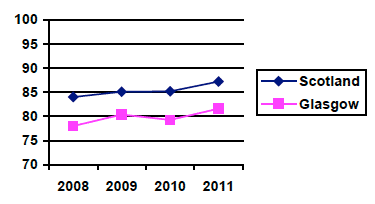
Source: School Leavers Destination Survey
F6: Modern Apprenticeships - new starts, in training and leavers
Why is this indicator important? Modern Apprenticeships offer people aged over 16 the opportunity of paid employment combined with training at different levels. They help people gain skills and nationally recognised qualifications without full time study and are available across a wide range of industries. The Legacy 2014 Young Persons Fund and Glasgow City Council's Commonwealth Apprenticeships will contribute to the development of modern apprenticeships over the next few years. We note that the key evidence we may require in the future will not be this indicator in itself, but a longer-term follow-up of those who complete these apprenticeships to determine their success.
Modern apprenticeships, Scotland 2008-2011
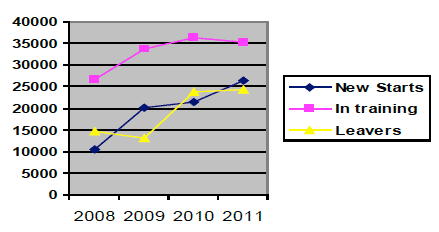
Source: Skills Development Scotland
What do the data tell us? There has been an increase in new starts, those in training and leavers from modern apprenticeship schemes between 2008 and 2011 at national level. By 2011, 35,262 modern apprentices were 'in training' across Scotland. This represents a substantial increase since 2008 when 26,614 were 'in training'. As we would expect, there is also a corresponding increase in both 'new starts' and 'leavers' over this 4 year period.
As we might expect, there has also been an increase at Glasgow level of new starts, those in training and leavers from modern apprenticeships between 2008 and 2011. By 2011, 4,201 modern apprentices were 'in training' in Glasgow. A substantial increase from the 2008 figure of 2,792. There is, unsurprisingly, a corresponding increase in new starts and leavers over this period. In 2011 the Glasgow City Council apprenticeship scheme had over 600 participants, making an important contribution to the overall total in Glasgow.
Modern apprentices in Glasgow 2008-2011
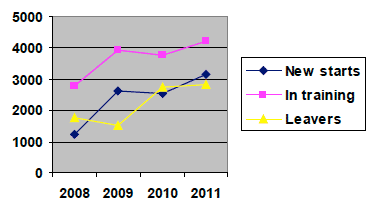
Source: Skills Development Scotland
F7: Percentage of adults providing help to organisations or groups
Why is this indicator important? This indicator provides a population-wide measure of unpaid help to organisations or groups, which we are using as an indicator of volunteering. If a demonstrable legacy from the Commonwealth Games is an increase in volunteering we would hope to see some change in this indicator.
Percentage of adults providing unpaid help to organisations or groups
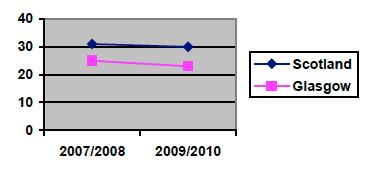
Source: Scottish Household Survey
What do the data tell us? The proportion of people providing unpaid help to organisations or groups has remained fairly constant since 2007 nationally and in Glasgow. A total of 30% of Scottish adults provided unpaid help in 2009/2010 compared to 31% in 2007/2008. There are similar percentages of men and women overall (27% of men and 31% of women in 2009/10). The biggest difference between males and females is within the 35 to 44 age group, where a higher proportion of females (38%) provided unpaid help than males (29%). This is also lower among men aged 25 to 34 compared to some of the other age groups; just over one fifth (22%) of men in this age group reported providing unpaid help. Around one-in-five (22%) of all adults from lower income households (earning less than £15,000) provided unpaid help in the last 12 months, compared to nearly twice that (41%) among those with a net household income of more than £40,000. In Glasgow 25% of adults provided unpaid help to organisations or individuals in the last 12 months in 2007/2008 and 23% in 2009/2010. In future reports we also expect to provide results disaggregated by type of unpaid help - including 'sport-related'.
3) Improve the perception of Scotland as a world class destination for business, events and tourism
Seven indicators have been selected under this intermediate outcome; two measure of perception of Scotland from the Nations Brand Index (NBI), some city ranking indexes for Glasgow, total visitor numbers and expenditure, and hotel occupancy. These indicators are generally available on an annual (or more regular basis), though Scottish questions on the NBI are moving to a bi-annual basis and will next report later in 2012 and 2014.
F8: Perception of Scotland internationally - Nations Brand Index, exports
Why is this indicator important? This indicator represents Scotland's reputation abroad in terms of its economic strength and potential. The survey asks three questions which cover science and technology, products and services, and leading creativity and innovation. These data are based on yearly interviews with approximately 20,000 adults aged 18 above in 20 core panel nations. Participants score 50 target nations on six dimensions, including exports.
Natins Brand Index scores: exports
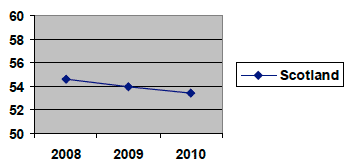
Source: Nations Brand Index
What do the data tell us? The exports dimension has changed very little from 2008 to 2010. It is ranked 21st out of 50 participating nations in 2008, 22nd in 2009 and 23rd in 2010. It is important to note that the rank order is dependent on which target nations are included. These tend to vary from one year to the next. The survey data shows that panellists who tend to be most familiar with and favourable towards Scotland overall are from English-speaking and Commonwealth nations and close European neighbours. For the purpose of comparison over time, the overall score which can range from 0 to 100 is therefore more informative. The score varied from 54.6 in 2008 to 53.45 in 2010. Looking at each of the 3 elements scored within Exports, Scotland's reputation for products and services was its strongest ranking question in this dimension (17th). However, Scotland's scores in these areas tended to fall in "don't know/neutral" categories, suggesting that people did not recognise Scotland for Exports when thinking about its reputation, rather that giving a negative/poor reputation for Exports.
F9 Perception of Scotland internationally - Nations Brand Index, tourism
Why is this indicator important? This indicator represents Scotland's reputation abroad in terms of its image as a tourist destination. The survey asks questions which cover participants' willingness to visit (money being no object), natural beauty, historic landmarks and city/urban attractions. As noted earlier, these data are based on yearly interviews with approximately 20,000 adults aged 18 above in 20 core panel nations.
Nations Brand Index scores: tourism
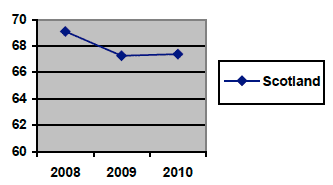
Source: Nations Brand Index
What do the data tell us? The tourism dimension remains Scotland's reputational 'peak' on the Nations Brand Index. It is ranked 12th/13th out of 50 participating nations in 2008-2010. As aforementioned, rank order is dependent on which target nations are included. For the purpose of comparison over time, the overall score which can range from 0 to 100 is therefore more informative. The score varied from 69.10 in 2008 to 67.39 in 2010.
F10: Rank and score as a business location (best city to locate a business today among European cities)
Why is this indicator important? The Cushman and Wakefield European Cities Monitor examines key issues that organisations consider when assessing new locations for business. The specific question we are using as an indicator is 'best city to locate a business today', and addresses a specific component of international reputation. We might hope to see an effect on this indicator based on the preparation and hosting of the Commonwealth Games. In 2011 senior executives from 501 European companies gave their views on Europe's leading business cities.
What do the data tell us? The Table below shows Glasgow's rank and score between 2008 and 2011. There has been a slight improvement in score over time, sitting at 0.05 in 2011. It is important to note that the denominator number of cities included changes over time.
Table F5 Scores and Rank for Glasgow from Cushman and Wakefield Monitor 'best city to locate a business today'.
| 2008 | 2009 | 2010 | 2011 | |
|---|---|---|---|---|
| Rank | 26 (of 34) | 29 (of 34) | 29 (or 36) | 30 (of 36) |
| Score | 0.03 | 0.04 | 0.04 | 0.05 |
Source: Cushman and Wakefield Monitor
F11: Rank and score as a major event destination
The data to be used for this indicator is yet to be determined. We have looked at a number of possible measures of Scotland or Glasgow as a major event destination. This includes the International Association of Conference Centres (IACC) rankings and other city indexes. We are also looking at the Global Sports Impact Project (GSI) that Sportcal are currently developing. Their aim is to create an internationally accepted methodology for measuring the impact of events thus enabling events to be compared across a standard set of indicators. We hope to report on this indicator in 2014.
F12: Visits from UK and Overseas Tourists (Trips)
Overseas visits to Scotland are estimated using the International Passenger Survey. The data are published quarterly by the UK Office for National Statistics. Domestic visits by Great British residents are currently estimated using the Great Britain Tourism Survey. These are published quarterly by VisitScotland.
Why are these indicators important? We would expect to see an increase in visits to Scotland and Glasgow around the time of the Games, and indeed in 2014 as a whole as a result of the Games, Ryder Cup and Homecoming that year. However, we may also expect to see a more sustained rise in domestic and overseas visits with the improved and new infrastructure described earlier and with an increase in the profile of Scotland internationally.
What do the data tell us? The number of combined visits to Scotland in 2011 was down 9% on the 2005 total, but there has been a slight increase between 2010/2011. And since the global recession in 2008 overseas visitor numbers have been relatively stable, falling slightly from 2.5 million in 2008 to 2.35 million in 2011. Domestic visits have increased from just over 12 million in 2008 to 13.4 million in 2011. Note that the 2011 figure excludes overnight visits from Northern Ireland. In Glasgow, the number of visits from within the UK increased from 1.68 million in 2008 to 1.75 million in 2010. From 2011 data are based on Great Britain visits (GB) rather the UK, and we see 1.73 million visits from within GB during 2011.35 There was a slight decrease in the number of overseas visitors to Glasgow from 0.63 million in 2008 to 0.48 million in 2011.36
Total Overnight Tourism Visits to Scotland - 2005 to 2011
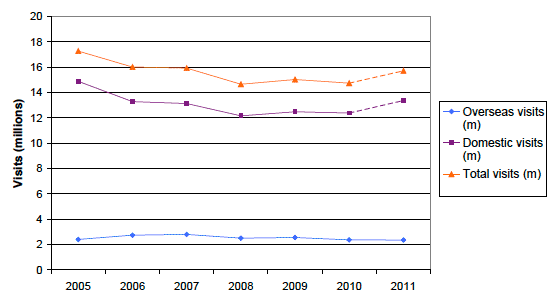
Source: International Passenger Survey (2005-2011), UK Tourism Survey (2005-2010), GB Tourism Survey (2011) – note this excludes overnight visits from Northern Ireland
F13: UK and overseas tourist expenditure
Why are these indicators important? In addition to seeing an increase in visits per se we might also hope to see an increase in tourist expenditure, particularly if the marketing of the Games to target, high yield countries is successful.
What do the data tell us? Adjusting for inflation using 2011 prices, expenditure from overseas visits has remained relatively stable over the three years since 2008 at just under £1.5 billion. Expenditure from domestic visits has shown a bounce back in 2011 to around £3.0 billion. Using 2011 prices, in Glasgow expenditure from domestic overnight visits from the UK has fallen from £415 million in 2008 to £375 million in 2010. It should be noted that in 2011 visit data changed to relate to GB rather than the UK; expenditure data for GB in 2011 is £385 million in Glasgow.37 Using 2011 prices, international spending patterns in Glasgow have increased from £222 million in 2008 to £236 million in 2010 before falling to £193 million in 2011.38
Expenditure by overnight visitors to Scotland 2005 - 2011 (in 2011 prices)
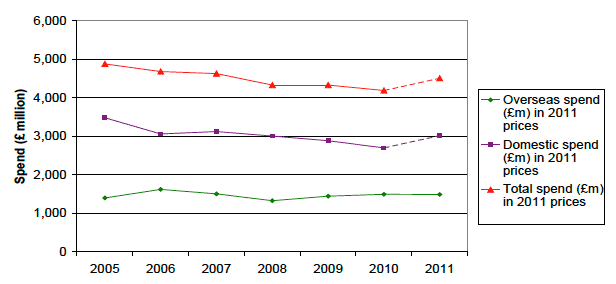
Source: International Passenger Survey (2005-2011), UK Tourism Survey (2005-2010), GB Tourism Survey (2011) – note this excludes overnight visits from Northern Ireland
F14 Hotel occupancy (Glasgow) - Annual Average Hotel occupancy (%) and July/August occupation
Why is this indicator important? Hotel occupancy in Glasgow can be used as an indicator of economic activity and international reputation. We would clearly expect to see an increase in hotel occupancy rates at the time of the Games, but also more genrally in response to an increase in international reputation and profile. Hotel occupancy data is collected through the Scottish Accommodation Occupancy Survey which is used extensively by VisitScotland.
What do the data tell us? Both the Scottish and Glasgow hotel occupancy rates have increased since the baseline of 2008. This is both annually (see graph) and for the summer quarter (which we've defined as the period July - September). By 2011 hotel occupancy annually was 65% in Scotland and 69% in Glasgow. This was from a 2008 baseline of 63% and 63% respectively. For the summer period hotel occupancy was 79% for Scotland and 81% for Glasgow. This was from a baseline of 74% and 76% respectively. Over this period it should be noted that Glasgow has seen an increase in supply in the hotel sector.
Hotel occupancy annually (%) Scotland and Glasgow
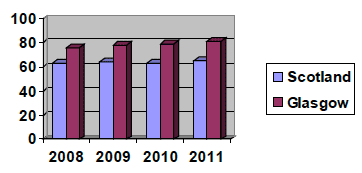
Source: Visit Scotland
Conclusions
Overall it is too early to make judgements about the contribution of the Games to any shift in these indicators. As we would expect in an economic downturn, GVA and employment have, in the main, decreased across key sectors between 2008 and 2010 - both at national and Glasgow level. The Scottish economy entered recession in early 2008 before returning to growth in late 2009. The proportion of people providing unpaid help to organisations or groups has remained fairly constant since 2007 nationally and in Glasgow and we may not expect to see any change in that indicator until nearer Games time. Since the recession in 2008 overseas visitor numbers have been relatively stable, but domestic visitors have increased. Adjusting for inflation, overseas visitor expenditure has remained relatively stable over the three years since 2008, whereas domestic visitor expenditure has shown a bounce back in 2011. There has been an increase in annual and seasonal hotel occupancy since 2008. Other indicators of city and international reputation have remained relatively constant since 2008.
Contact
Email: Imelda Giarchi
There is a problem
Thanks for your feedback